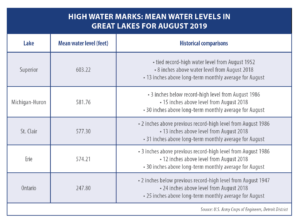Great Lakes-St. Lawrence Legislative Caucus hears options for dealing with shoreline erosion caused by near record-high lake levels
With water levels in the Great Lakes surging to or above record high levels, coastal communities along all five lakes are scrambling to deal with erosion and flooding woes. During a September 6 web meeting, members of the Great Lakes-St. Lawrence Legislative Caucus heard from David Hart, assistant director for extension at the University of Wisconsin’s Sea Grant Institute, about the impact of high water levels in the Great Lakes and what communities can do to mitigate its effects.
Based on his work with a shoreline stabilization effort in Milwaukee and Ozaukee counties in Wisconsin, Hart said myriad options have been developed, or are available for state and local officials to use:
- Options for erosion control and bluff stability include relocation of buildings, “green” infrastructure and mandating low-impact development on blufftops.
- Options for structural shore protection include building revetments (slopes built to absorb the energy of incoming water), sea walls, breakwaters, or groins (structures that look like a small breakwater and create or maintain beaches on their updrift sides).
- Options for bluff stability practices include blufftop stormwater management, bluff “dewatering,” use of vegetation and green infrastructure, regrading and/or terracing.
- Options for nature-based shore protection include incorporating vegetation into revetments and breakwaters, building artificial beaches, and beach sand replenishment.
Hart said policy coordination can help local governments manage erosion problems; they could coordinate land use ordinances or blufftop management programs, or engage in cost-sharing efforts.
He also singled out state legislation from 2018, including Indiana’s SB 178, which requires companies removing sand for port and industrial water intake pipes to deposit that sand onto regional beaches rather than offshore; and Ohio’s HB 709, which lets homeowners on impacted coasts create a “special improvement district” to use an additional property tax levy to pay for shoreline improvements.
